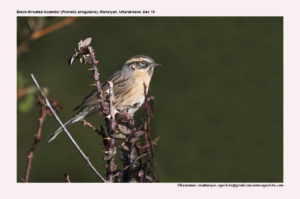
Black-throated Accentor Prunella Atrogularis
Etymology
- Prunella : Braunelle – German for brown
- Atrogularis: Latin word Atro – Dark, Gularis – Throat
Distribution in India: Winter visitor to North and West Himalayas in India.
Description: Size of 15 cm; wt. of 19 g. The nominate race has crown and nape as greyish-brown with black streaks and black border, long pale cream supercilium. It has blackish ear-coverts separated from black of chin and throat by thin pale malar stripe. The side of neck is grey; mantle and scapulars are grey-brown, streaked blackish-brown. The back, rump and tail are olive-brown; wings are blackish-brown, tertials and secondaries are edged buff, white spots at tips of median and greater wing-coverts; below, pronounced white gorget around black throat, grading to rich buff on breast and flanks. The flanks are with brown streaks and chest side is with less distinct spots; belly and vent are cream-coloured; dark areas become darker and underparts paler when plumage is worn. The iris is brown; bill is blackish, paler base of lower mandible; legs are brownish to yellow-brown or pinkish-brown. Both the sexes are alike. The juvenile has head pattern more poorly defined than adult, with narrower supercilium, no grey patch on neck, also duller, less clearly streaked upperparts, and throat is grey-brown with pale speckling, underside more streaked.
Habitat: In summer It is found in low, thick, thorny scrub and avoids open habitats: in clumps of stunted spruce .It is found up to 3000 m. In winter it is found in scrub-jungle, tea plantations and other cultivated habitats. It is found below 1800 m.
Food habits: It eats insects and small arthropods, worms and snails. It eats seeds, mainly in winter. It forages on ground in dense shrubs, woods, grassy clearings, and banks of rivers and streams. In winter, forages in scrubby forest, bushes, and patches of weeds and reeds, either solitarily or in small parties.
Breeding habits: They breed in May–Aug. They have 2-3, broods. The nest is built by female. The nest is a bulky cup of moss, twigs, grasses and stems, lined with fine grass and hairs, placed usually in tree or shrub, mostly in spruce or juniper. They lay a clutch of 3–5 eggs. The incubation is done by female alone. The incubation period is 11–14 days. The nestlings are fed by both sexes, more by female. The young fledge at 11–14 days.